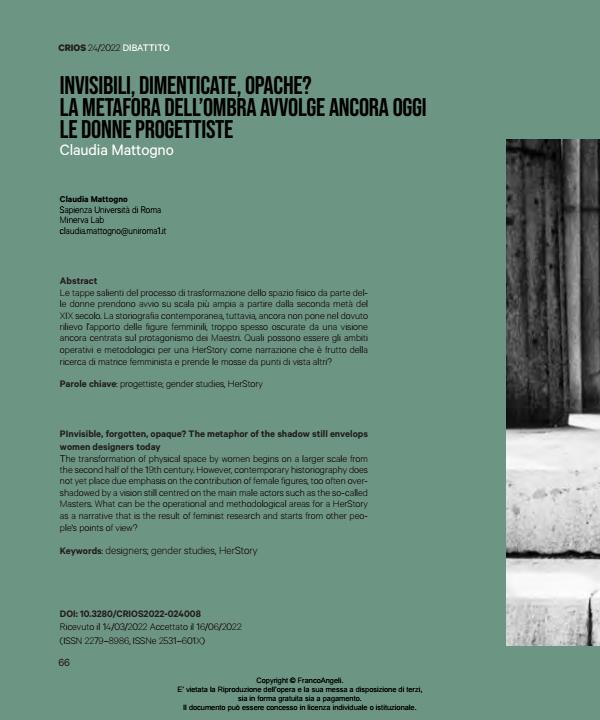PInvisible, forgotten, opaque? The metaphor of the shadow still envelops women designers today
Journal title CRIOS
Author/s Claudia Mattogno
Publishing Year 2024 Issue 2022/24 Language Italian
Pages 8 P. 66-76 File size 118 KB
DOI 10.3280/CRIOS2022-024008
DOI is like a bar code for intellectual property: to have more infomation
click here
Below, you can see the article first page
If you want to buy this article in PDF format, you can do it, following the instructions to buy download credits

FrancoAngeli is member of Publishers International Linking Association, Inc (PILA), a not-for-profit association which run the CrossRef service enabling links to and from online scholarly content.
The transformation of physical space by women begins on a larger scale from the second half of the 19th century. However, contemporary historiography does not yet place due emphasis on the contribution of female figures, too often overshadowed by a vision still centred on the main male actors such as the so-called Masters. What can be the operational and methodological areas for a HerStory as a narrative that is the result of feminist research and starts from other people's points of view?
Keywords: designers; gender studies, HerStory
- Bonfiglioli S. (1994). Il Piano degli orari. Antologia di materiali per progettare ed attuare politiche pubbliche. Milano: FrancoAngeli.
- Borghi R., Rondinone A. (2009). Geografie di genere. Milano: Unicopli.
- Coutras J. (1996). Crise urbaine et espaces sexués. Paris: Armand Colin.
- Curtis W. (2006). L’architettura moderna dal 1900. London: Phaidon. Fernández García A.M., Franchini C., Garda E., Seražin H. (a cura di) (2018), MoMoWo. 100 works in 100 years. European Women
- in Architecture and Design: 1918-2018. Ljubljana-Torino: France Stele Institute of Art History ZRC SAZU Politecnico di Torino.
- Friedan B. (1963). The Feminine Mystique. New York: W.W. Norton. (Trad. It. La mistica della femminilità, Milano, 1964).
- Gelini F., Zambianchi M. (2016). A History, Concepts and Practice of Time Policies and Time Planning. The Bergamo Case. In De Madariaga I. S., Roberts M. (a cura di) (2016), Fair shared cities: the impact of gender planning in Europe, London-New York: Routledge.
- Giedion S. (1975). Spazio, Tempo e Architettura. Milano: Hoepli. Greed C H. (1994). Women & Planning, Creating gendered realities.
- London: Routledge.
- Griswold Tyng A. (1989). From Muse to Heroine. Toward a visible creativity identity. In Perry Berkeley E., McQuaid M., (a cura di), Architecture. A place for women. Washington and London: Smithsonian Institution Press.
- Gürel M.O., Anthony K.H. (2006). The canon and the void: Gender, Race, and Architecture History Texts. Journal of Architectural Education, 59 (3): 66-77.
- Hayden D. (1980). What would a non-sexist city be like? Speculation on Housing, Urban Design, and Human Work”. Sign 5 (3): 170-187.
- Hayden D. (1982). The grand domestic revolution. A History of Feminist designs for American Homes, Neighborhoods, and Cities, Cambridge-London: The MIT Press.
- Ilonen A. (1982). Profiles from the master’s shadows: Lily Reich, Eileen Grey. Arkkkitehteja/Architects.
- Kingsley K. (1988). Gender Issues in Teaching Architectural History.
- Journal of Architectural Education, 41 (2): 21-25.
- Matrix (1984), Making space: women and the man-made environment. London: Pluto Press.
- Mattogno C. (2014). Lo spazio urbano tra ricerca e progetto. Note per una lettura di genere. Territorio, 69: 20-26.
- Muxi Martinez Z. (2021). Beyond the threshold. Women, houses, and cities. Barcelona: Dpr.
- Rendell J. (2000). Introduction: Gender, Space, Architecture” in Gender Space Architecture. An interdisciplinary introduction. London-New York: Routledge.
- Robert M., Sanchez de Madariaga I. (a cura di) (2013), Fair shared cities. The impact of gender planning in Europe. London-New York: Routledge.
- Spain D. (2016). Constructive Feminism. Women’s Spaces and women’s right in the American Feminism. New York: Cornel University Press.
- Torre S. (1977). Women in American architecture. A historic and contemporary perspective. New York: Whitney Library of Design.
- Walker L., Darling E., (2017). AA Women in Architecture 1917-2017.
- London: Architectural Association.
Claudia Mattogno, Invisibili, dimenticate, opache? La metafora dell’ombra avvolge ancora oggi le donne progettiste in "CRIOS" 24/2022, pp 66-76, DOI: 10.3280/CRIOS2022-024008